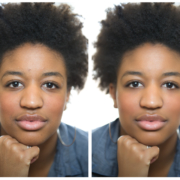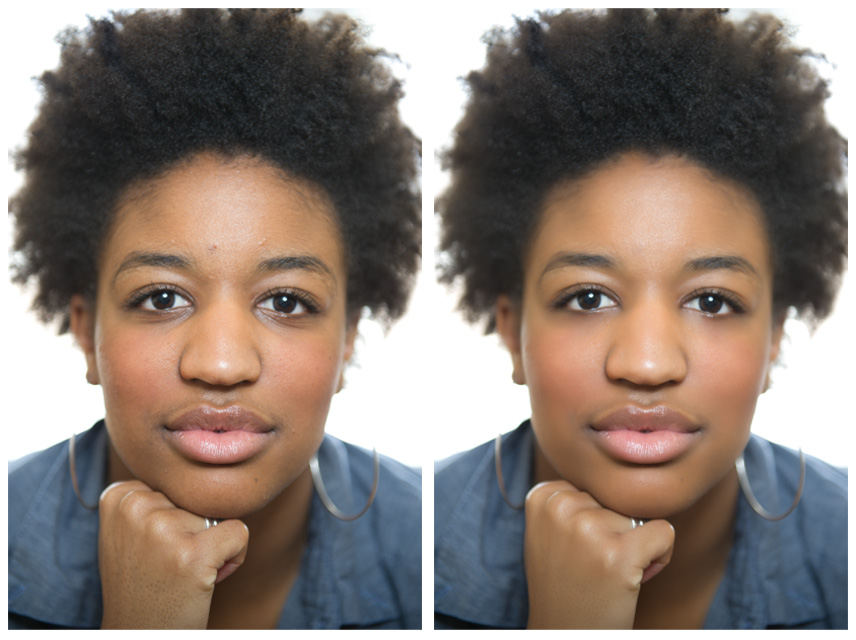To Retouch or Not to Retouch, THAT Is the Question
This morning I read an article by Beate Chelette, (http://PhotoBizCoach.com), titled “Advertising Under Fire for Doctored Images” asking photographers where they stand on the issue of retouching images and the ethics of doing so. Click the links above and read the story. It’s short; I will wait here for you.
Tap, tap, tap…. Oh you’re back. Sorry, I got distracted.
If you read the article you may have seen my response as well: “Some retouching is a good thing, too much, not so good.” I whole heartedly believe that and I live it with my work too. I am not opposed to doing whatever my client wants. If the client wants china doll skin, I can do that. However I prefer to keep the image looking real.
Even with keeping it real there are things that need to be retouched. I know that people want to look their best when they have their picture taken. In the past I have written articles on retouching and said not to worry about the inopportune pimple or shaving nick. These things are easily and quickly fixed in post-production. At the same time I can smooth the complexion without removing the texture of the skin. Many retouchers do the smoothing of complexion and lose the look of real skin. The fact is that people have pores and you can see them which means an image of that person, especially if a close-up, should show them!
Below you can see side by side an untouched image and a retouched image. The image on the left is straight out of the camera and the one on the right is retouched in a believable way, not overdone.
You’ll notice you can still see the texture of Sydni’s skin. The pores are still visible and the smoothness is actually created with depth of field by using the correct F-stop, not Photoshop.
Retouching can be done for effect too. In the image below the image “out of camera” on the left is close to the effect that I wanted for this shot. At the same time it needed a little retouching to create the drama that I was aiming for. The final image on the right is after I applied some retouching and a couple of effects to bring the drama out in the image.
Retouching is an art but at the same time it is only a tool. To get the look you want most of the work should be done in camera and retouching methods should only be used to bring out the end result you are striving for.
What look would you like? Let’s play together and get that look captures your best side.






Yes Michael.
Retouching in corporate and social portraits is mostly expected, but care must be taken not to change a person’s identity. The truth matters in advertising when you are selling a skin care product.
Got here from your tweet.
I think much of this is what we get used to seeing. And that may be different here in the UK to that in the USA or other countries. And the OVERRIDING issue, as with all this stuff including the HDR debate, is if you are pro it is what your clients brief is about. Yes add what you like as an alternative but give the clients what they are paying for first.
Michael, my view in your two examples is that the original images to my eyes are way better that the retouched version. In the first one it is so obvious that it is ‘air brushed’ to use the phrase is going round the press just now. Character is lost in the girls face and unless she is a model for clothes or make up – which is not not being portaryed – then why smooth everything over. Actauly her complexion is very nice and make up show naturally. Leave it be.
But then is that a UK view of the work??
Simon
Simon – in the first image the only reason, I feel that the retouch is obvious is the eyes. The client/model felt she looked tired as she had been out late the night before. She asked, “Can you remove the bags from under my eyes?” She was writing the check so the answer was “sure!” Normally what I would do is lighten the lines and that can be done by a good MUA as well. Other than that the texture is there and you can see it in large images very easily. That first shot was done at f1.4 so its going to be a tad soft at the nose and the ears.
I tend to agree with Simon regarding the first image. I think it is overdone and takes on that fuzzy/putty skin like look. I tend toward more realism in my portraits unless the intention is to clearly make the image appear more surreal and ethereal. Character in the eyes and mouth is what enhances the image and conveys the character of that person.
I agree with everyone. However, it all comes down to the client paying for the work. I do agree that it’s a little bit too much retouching (detail in the eye brows are lost, shape in the knuckles are lost), but if the client is very happy with the look, who is too say that it’s too much retouching. They are the ones who are paying for it, so be it. Working full-time as a digital retoucher doing magazine, DVD movie packaging, and catalog work, I have done both realistic retouch to over-the-top retouch look. It’s always the art director’s call since he/she marks up the work. I’m just here to create the magic for them based on what I think they are envisioning. Sometimes I get it right the first time around, and other times there are several rounds of retouch.
I’ve worked in advertising for years, right across the hall from the editorial department. As far as my colleagues in editorial are concerned, advertising has no ethics. (So I retouch away, painting away brown grass in a real estate image, making folks thinner, adding limbs back that have been unfortunately cropped… this was for a paid obit.)
Still, while I do agree that skincare products should use images with minimal “skin softening,” if I’m shooting Julia Roberts, I’m going to make her look her best. Therefore, they should pick their models accordingly.
I have absolutely no problem retouching for portraiture. and actually it is expected by clients. But there are limits. Sure there are some things that need to be done in camera within reason but the final finishing happens on the computer for my work. I would not like to shoot at f1.8 when f8 is called for just to get a skin softening effect when I can do a more effective (and sellable) job in post.
Product photography and advertising photography is a different beast … the images have to be perfect and if he need arises to rebuild a corner or correct a manufacturing defect then I am all over it. Advertising IMHO is not “real world” it is to entice a purchase therefore more “liberties” are expected in post processing